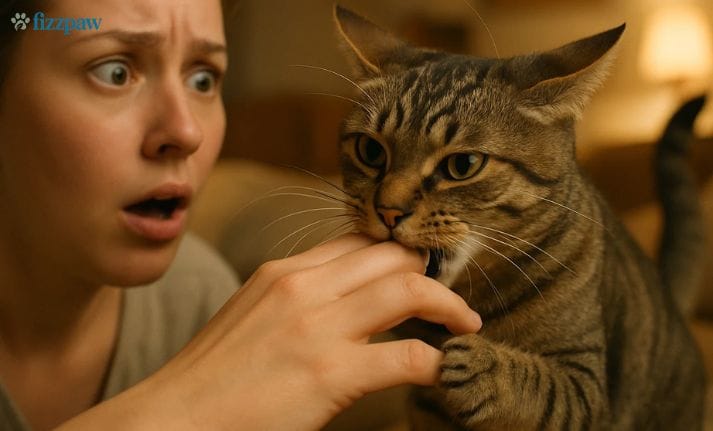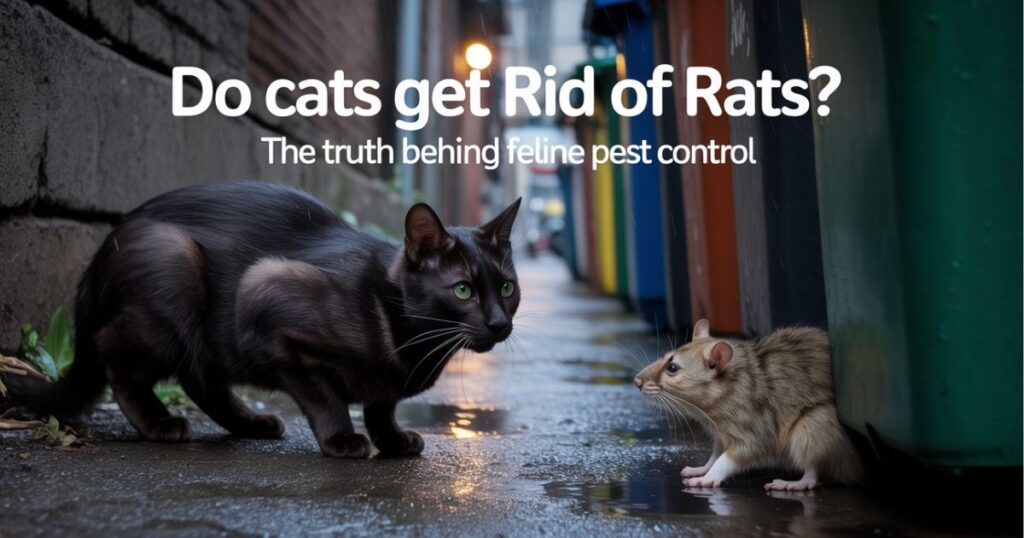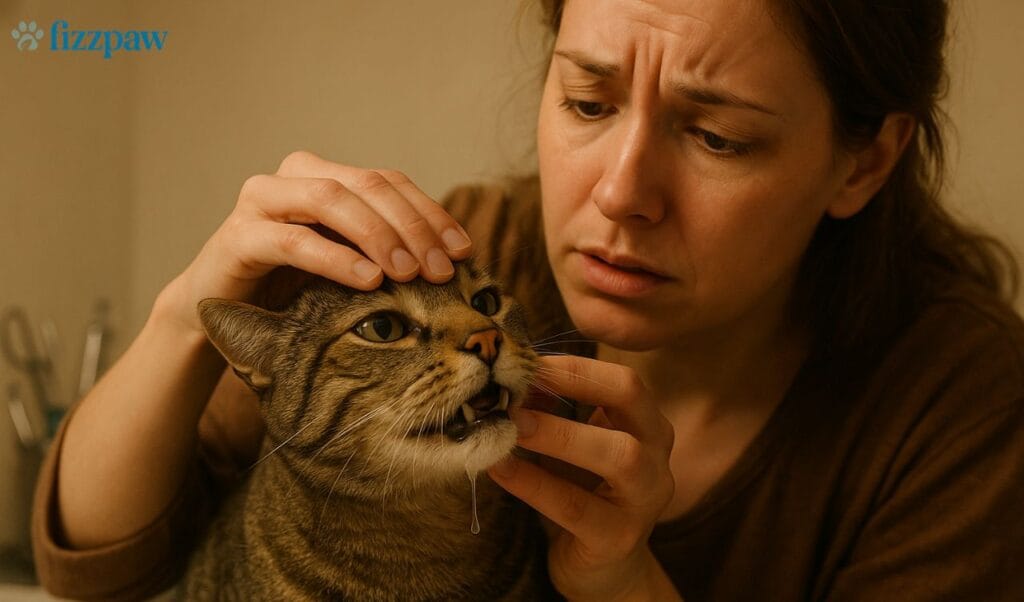Have you ever wondered about asking a question, “Why does my cat bite me and then lick me”? Well, you are not the only one. This behavior of some cat parents is indeed difficult to understand and at times, very painful. Even though you may think it is very hostile or arbitrary, this blend of nipping and tongue is usually your cat making his or her own form of communication.
By means of body language, combined with grooming activity, cats convey affection, assert distance, or indicate excessiveness. Knowing these signs can help you build a stronger and more positive bond with your cat. In this guide, we will not only find out what the true causes are of this strange behavior, but we will also learn how to react to such behavior and when it is actually an indication that a dog is in pain or stressed.
What It Means When a Cat Bites Then Licks You
This happens when a cat bites you, followed by licking; more often than not, the cat communicates. It may show love, annoyance, or even stimulation. When cats groom each other, they frequently bite each other (but not a lot) before licking. When such behavior is targeting you, it resembles the behavior of cats as predators, the combination of love and dominance.
The second reason is that your cat is an over stimulated cat. Once you find some enjoyment in petting, your hands may get to be too much, in which case they inspire a nip and subsequent lick as one of apologizing. It might just be a carryover of kittenful play, since the same happens during rough play with cats.
Other cats bite and lick when they do not know how to show emotions. Some of the signs of anxiety, e.g., in cat anxiety, are unpredictable nipping accompanied by licking, particularly among the stressed indoor cats.
7 Common Reasons Cats Bite Then Lick
To truly understand why does my cat bite me, it’s important to explore the underlying reasons behind this curious behavior. Here are the main causes:
| Reason | Explanation |
| Love Bites | Gentle nips followed by licking are a form of affection. Known as cat love bites. |
| Overstimulation | Petting for too long can lead to petting aggression. |
| Play Aggression | During games, cats often bite and lick. Common in the kitten biting phase. |
| Stress or Anxiety | Cat anxiety signs include licking, biting, hiding, or sudden scratching. |
| Pain or Illness | Pain-induced aggression may trigger unexpected biting. Always consider a vet consultation. |
| Grooming Behavior | Cats groom by biting and then licking their fur. It can spill over to humans. |
| Territory & Control | Some cats bite to show dominance, then lick to “make peace.” |
One common reason your cat may bite and then lick you is natural predator behavior in cats. This bite-lick action often mimics how they interact with prey in the wild. Cats are natural hunters—even if they live indoors. You may be surprised to learn that cats can actually help control rodents around the home. Do cats really get rid of rats? The truth might surprise you.
Bite Then Lick vs. Other Cat Behaviors: What’s the Difference?
These are acts of licking followed by biting, which are mostly affectionate or playful. However, when cats bite you when you are petting them or make a quick nip without a lick, they may show fear-induced aggression or also redirected aggression. When biting becomes difficult and persistent, then it is definitely not adorable but a sign.
There is one more hint, which is context. Play aggression may be expressed by your cat hugging your arm, kicking with a back leg, and biting. However, it might be something different when there is a quiet, strong bite during cuddling. Find out how to identify the signs of cat bites early enough.
Male vs. Female Cat Behavior Differences
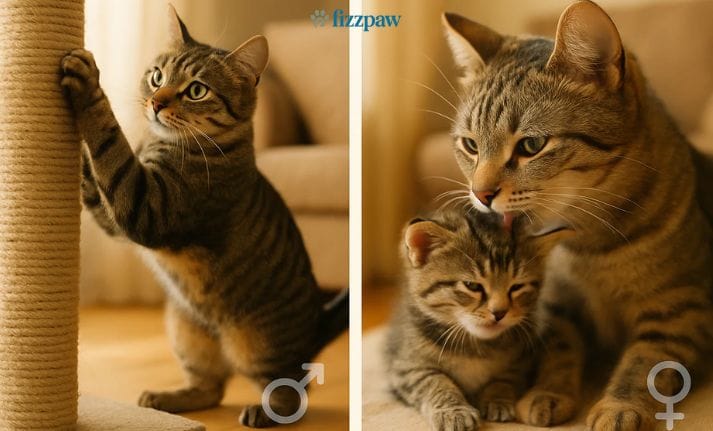
Male cats, especially unneutered ones, often display more play aggression in cats. Females, on the other hand, may be more territorial and sensitive to over-petting. Hormones play a huge role in how cats show affection and control. Neutering helps reduce sudden cat aggression.
Does My Cat Love Me or Is It Annoyed? Understanding Feline Emotions
It is slow work to decode emotions in the cat. A lax tail, relaxed blinking eyes, and a purr indicate endearment. On the other hand, the tail flicking, ears flattening are indicators of irritation as it is done with the whiskers protruding forward. When your cat becomes affectionate but unexpectedly attacks you, then you have an oversensitized cat.
You might ask, “Why does my cat bite me and no one else?” It’s often because you’re the primary caregiver. Cats show their truest behaviors to the person they trust the most. It may look like aggression, but it’s often a backhanded sign of love.
When Does This Behavior Usually Happen? Scenarios to Watch
Knowing the time to avoid will assist you in avoiding the act. Be on the watch out of these typical situations:
- During intense playtime
- When you’re petting their sensitive areas (belly, base of tail)
- After grooming
- When your cat is tired or agitated
Sometimes this happens when your cat is feeling territorial. If another pet just left the room or a new scent is in the home, your cat may bite and lick you out of confusion.
Should I Be Concerned? When Biting Turns Problematic
Most of the time, this behavior isn’t harmful. But if you’re wondering why does my cat bite me more often or more painfully, or notice a change in their personality, it’s best to consult a vet. Look out for:
- Excessive biting without a playful context
- Hissing, growling, or hiding
- Pain-induced aggression during petting
- Sudden fear or avoidance
These may point to deeper issues requiring cat behavior modification or professional support.
How to Respond When Your Cat Bites and Licks You
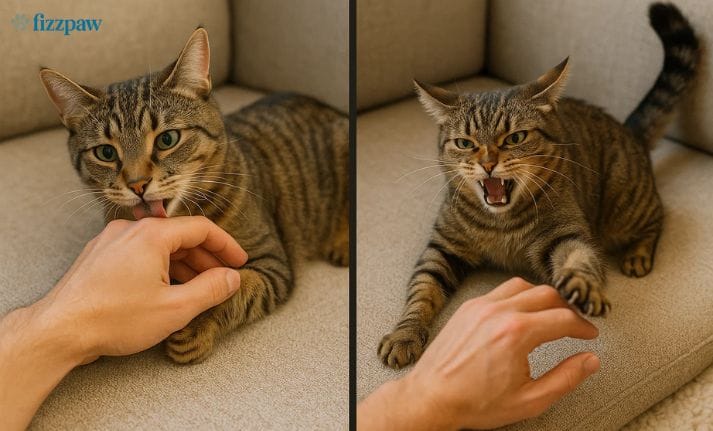
Never punish your cat. Instead:
- Stop the interaction immediately
- Gently place the cat down and walk away
- Use interactive cat toys to redirect the energy
- Observe what triggers the behavior
Over time, you’ll learn to spot signs a cat is about to bite. For example, a twitching tail or flattened ears means “back off.” Respecting those signals builds trust.
How to Prevent This Habit with Positive Reinforcement
Use clicker training for cats or training a cat with treats to encourage soft play. Stop the play session if biting starts. Avoid rough games using your hands. Instead, try:
- Cat toys that dispense food
- Scratching posts and cat enrichment tools
- Puzzle toys and feather wands
- Rotating toys weekly to prevent boredom
This teaches bite inhibition and gives your cat healthy outlets for energy.
Decoding Your Cat’s Body Language: What Every Move Means
Watch for these signs:
| Signal | What It Means |
| Tail flicking | Annoyed or overstimulated |
| Ears back | Warning to stop touching |
| Whiskers forward | Alert or excited |
| Pupils dilated | Over-arousal |
Reading feline body language helps you act before the bite happens. Understanding how to handle cats properly is key to bonding.
When to Get Professional Help (Vet or Behaviorist)
Seek help when:
- Biting turns violent
- Your cat shows cat biting problems across different situations
- You suspect a medical issue
- Stress signs persist despite toys or routine
Reach out to a cat behaviorist or schedule a vet consultation to check for any underlying medical issues. You can search certified experts via American College of Veterinary Behaviorists.
Personal Story: How My Rescue Cat Taught Me Patience
In my case, I got a rescue dog that was 1 year old and named Milo; wherever I pet him, he bites me. I did not get it initially. However, after some time, I found that it only occurred after 10-15 seconds of brushing. He was giving me cues I had not noticed: tail flicks, minor body muscle twitches, and a rapid movement of the head.
When I noticed these signals, I paused the petting and gave him some space.I also started using interactive cat toys like feather wands and puzzle feeders to keep him mentally and physically engaged. I combined that with clicker training and a positive reward–treats whenever he would remain calm. In a couple of weeks, his cat’s biting when being petted disappeared. Milo curls up next to me now and does not bite, just purrs and gives me headbutts.
The secret was to learn how to communicate with his cat.
Frequently Asked Questions
Why does my cat try to bite me randomly?
This often happens due to overstimulation, sudden fear, or play aggression—it’s your cat’s way of reacting to discomfort or surprise.
What does it mean when a cat bites you?
A bite can signal love, annoyance, fear, or pain—understanding context and body language is key.
Is it common for cats to bite their owners?
Yes, many cats nip or bite occasionally, especially during petting or play, but it’s usually normal cat behavior.
How do you discipline a cat for biting?
Avoid punishment—use positive reinforcement, redirect with toys, and stop interaction when biting starts to teach better behavior.
Can clicker training stop biting behavior?
Yes. Clicker training for cats paired with positive reinforcement helps reduce unwanted biting and builds good habits.

